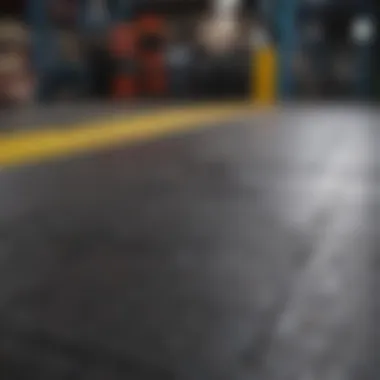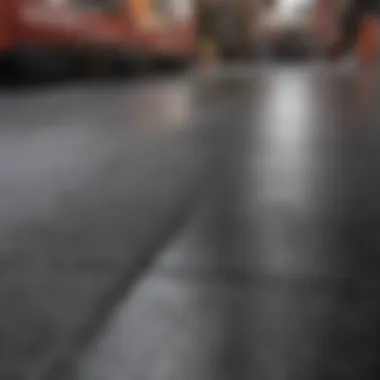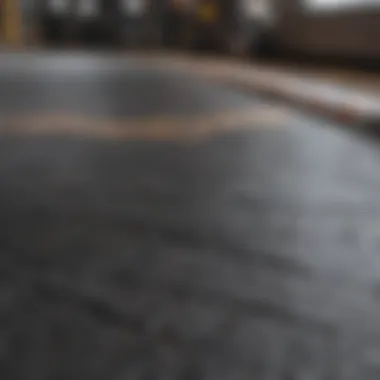Enhancing Cement Floors with Rubber Mats


Intro
Rubber mats offer diverse advantages when applied to cement floors. These mats not only contribute to aesthetic appeal but also enhance practicality across various environments. In residential spaces, they improve comfort, while in commercial and industrial settings, they bolster safety and functionality. This article explores the multiple benefits of rubber mats, aiming to provide insights into their types, maintenance, and selection criteria.
Understanding the relevance of this topic benefits not only homeowners but also health professionals and businesses. Selecting the appropriate mat for specific needs can lead directly to improved well-being and productivity.
Key Benefits
Physical Health Benefits
Rubber mats contribute significantly to physical health, especially in environments where individuals stand for extended periods. The cushioning provided by these mats offers support to the feet, reducing fatigue and minimizing discomfort. In commercial kitchens, for example, workers often face long hours on cement floors, which can lead to pain and various health issues.
In these settings, rubber mats can help alleviate some of these problems. They can absorb shock effectively, leading to a more ergonomic standing surface. This makes rubber mats essential in environments such as hospitals, gyms, and restaurants, where both safety and comfort are vital.
"Choosing the right flooring can have a substantial impact on employee health and productivity."
Mental Well-being Enhancements
A less obvious advantage of rubber mats is their impact on mental well-being. Environments that prioritize comfort contribute to enhanced focus and productivity. Soft flooring solutions can create more pleasant working conditions, leading to improved moods among employees.
In residential settings, rubber mats provide a warm, inviting floor for families. They also reduce the echo in rooms, promoting a calming atmosphere. The aesthetics of matting colors and designs can further influence an individual’s mental state, fostering a more positive living environment.
Practical Tips
Selecting the Right Rubber Mat
When choosing rubber mats, consider the specific needs of the environment. Key factors to examine include:
- Thickness: Thicker mats often provide more cushioning but may cost more.
- Texture: Different surfaces can offer varying levels of grip and comfort.
- Durability: Look for high-quality materials that resist wear from foot traffic.
- Maintenance: Some mats require more care than others; consider ease of cleaning.
Maintaining Rubber Mats
Proper maintenance ensures longevity. Regular cleaning is crucial. Here are some tips to maintain rubber mats effectively:
- Vacuum regularly to remove loose dirt and debris.
- Use mild detergent and water for deep cleaning.
- Avoid harsh chemicals that can damage the rubber.
- Check for wear or damage frequently and replace when necessary.
Prolusion to Rubber Mats for Cement Floors
Rubber mats are increasingly recognized as a vital addition to cement floors in various environments. The use of these mats addresses several concerns, including safety, comfort, and durability, making them a practical flooring solution. Their significance cannot be overstated, especially in spaces where foot traffic and activities are frequent.
Rubber mats serve multiple purposes. They provide a non-slip surface, which decreases the risk of accidents, making public and private spaces safer. Also, they add a layer of cushioning underfoot, which can ease fatigue during long periods of standing. This is particularly advantageous in settings such as gyms, kitchens, and retail stores where personnel often move around or stand for extended times.
Furthermore, the longevity of rubber mats is another reason for their practical usage. They are specially designed to withstand wear and tear. This resilience helps maintain the aesthetic and functional quality of cement floors over time.
The quality of flooring directly impacts the overall experience of users within any given context, whether residential, commercial, or industrial. Given the diverse applications of rubber mats, understanding their definition and importance is essential.
Definition and Overview
Rubber mats can be defined as flooring solutions made from rubber, designed to cover cement surfaces for various functional and aesthetic purposes. They come in different types and sizes, tailored to meet specific needs. Common uses include providing safety, enhancing comfort, and offering thermal insulation. This definition encompasses various styles, from interlocking mats to roll-out options, which suit diverse requirements.
These mats are usually constructed from durable synthetic rubber, ensuring longevity and ease of maintenance. They can feature finishes that enhance grip and resistance to environmental factors.
Importance of Flooring Solutions
In any space, the quality of flooring is crucial for overall utility and comfort. Cement floors, while robust, often lack the inherent qualities that make them suitable for various activities. This is where rubber mats become beneficial. They not only provide a functional surface but also contribute to a pleasant atmosphere.
There are several important reasons to consider proper flooring solutions:
- Safety: Rubber mats reduce slip and fall incidents, which can be a major concern in busy environments. Their texture helps maintain traction, vital in areas prone to spills or moisture.
- Comfort: The cushioning effect of rubber mats alleviates foot stress. This is vital for environments requiring prolonged standing, like hospitals or workshops.
- Aesthetic Appeal: Rubber mats come in a variety of colors and designs, allowing users to create visually pleasant spaces that also serve practical purposes.
Choosing quality flooring solutions can lead to improvements in worker productivity and overall satisfaction in any environment, emphasizing the practicality of using rubber mats on cement floors.
Benefits of Using Rubber Mats
The inclusion of rubber mats in various environments offers several benefits that are crucial for enhancing not only the flooring but also the overall safety and comfort of any space. Rubber mats feature distinct advantages that address specific needs, making them a valuable flooring solution in homes, commercial spaces, and industrial settings. Understanding these benefits allows individuals to make informed decisions about their flooring solutions and enhances their experiences in different environments.
Safety Features
Slip Resistance


Slip resistance is a prominent safety feature of rubber mats. This characteristic significantly contributes to reducing the likelihood of accidents caused by slips and falls. The textured surface of rubber mats provides excellent traction even in wet or oily conditions. This makes them particularly beneficial in kitchens, bathrooms, and areas where spills may occur.
A unique aspect of slip resistance is its ability to adapt to various conditions. Unlike hard flooring surfaces that can become dangerously slick, rubber mats maintain their grip under diverse circumstances. This feature is essential for both residential and commercial spaces where safety is a top priority.
Shock Absorption
Shock absorption is another vital aspect of rubber mats. This quality mitigates the impact on joints and feet when standing or performing activities on the floor. Such properties make rubber mats an ideal choice for settings like gyms or workshops where individuals spend extended periods standing or moving.
The cushioning effect of rubber can reduce fatigue, which is advantageous for workers in industries requiring long hours on their feet. By absorbing stress and distributing weight evenly, rubber mats protect users against potential injuries associated with prolonged standing.
Comfort Enhancement
Underfoot Support
Underfoot support is a significant benefit of rubber mats, enhancing overall comfort. This aspect is especially important for individuals who often stand for long durations. The soft yet resilient nature of rubber provides a comfortable surface that minimizes discomfort.
With the right type of rubber mat, individuals can experience a reduction in foot and back pain commonly associated with hard cement floors. This makes rubber mats a suitable choice for professionals such as health practitioners or fitness trainers, ensuring that their working environment supports their physical well-being.
Sound Dampening
Sound dampening is another remarkable advantage offered by rubber mats. It helps to reduce noise levels in both residential and commercial settings. The absorption of sound makes rubber mats especially effective in spaces like gyms or open-concept offices.
The unique feature of sound dampening contributes not just to a more pleasant atmosphere but also supports concentration and communication. Therefore, the placement of rubber mats can significantly affect productivity, especially in environments where noise control is vital.
Durability and Longevity
Resilience to Wear
Rubber mats display remarkable resilience to wear, making them a reliable flooring option. This durability ensures that they can withstand heavy foot traffic and various types of stress without significant damage.
The key characteristic of rubber's durability is its ability to retain functionality over time. Users can expect rubber mats to last longer than many other types of flooring, which is why they are a often chosen in high-traffic areas.
Weather Resistance
Another advantageous feature is weather resistance. Rubber mats can endure various environmental conditions, including moisture and temperature fluctuations. Their non-porous nature allows them to resist mold and mildew, making them suitable for outdoor applications as well.
This ability to withstand weather elements makes rubber mats a smart choice for areas exposed to the outdoor elements, such as patios or entranceways. Overall, the durability and weather resistance enhance the longevity and functionality of rubber mats across multiple environments.
Types of Rubber Mats Available
Rubber mats serve various purposes, making their selection crucial depending on your requirements. Each type has specific advantages that fit different contexts. Understanding these options helps you to make informed decisions, ensuring the mats serve their intended functions effectively. The three main types discussed here are interlocking mats, roll-out mats, and anti-fatigue mats.
Interlocking Mats
Interlocking mats are well known for their ease of installation. This type consists of individual tiles that connect together, forming a cohesive surface. You can customize the size and shape according to your space, making them exceptionally versatile.
Another benefit is their portability. If you need to reposition your mats, you can do so without hassle. These mats also have a good level of shock absorption. That is plus if you are using them in areas with high foot traffic, like workshops or gyms. Their individual pieces can be replaced easily if damaged, thus enhancing the longevity of the flooring.
Roll-Out Mats
Roll-out mats offer a straightforward solution for covering larger areas. They come in large sheets that you can spread across the floor, which makes them ideal for places where speed is a concern. Often used in industrial settings, these mats provide substantial coverage and help to minimize noise levels.
Additionally, they offer sound dampening qualities. This aspect is essential in environments like restaurants or gyms, where noise can disrupt activities. Roll-out mats are also simpler to clean. Their seamless design prevents dirt accumulation, leading to lower maintenance needs. Moreover, they are often designed with weather-resistant materials, facilitating their use in both indoor and outdoor applications.
Anti-Fatigue Mats
Anti-fatigue mats are specifically designed to improve comfort for individuals standing for long periods. They assist in alleviating fatigue and improving productivity. This type of mat encourages micro-movements in the legs and feet, which boosts circulation and reduces discomfort.
These mats are especially beneficial in environments like kitchens, retail stores, or workshops where personnel may be on their feet all day. By providing additional underfoot support, these mats minimize strain on muscles and joints, which is vital for overall well-being. Moreover, anti-fatigue mats often come in bright colors or designs, which can also enhance the aesthetics of your space.
"Choosing the right type of rubber mat can significantly enhance safety and comfort in various environments."
Selecting the appropriate mats involves understanding the specific needs of the environment. All three types have unique characteristics that cater to different applications. Whether it is the versatility of interlocking mats, the speed of roll-out mats, or the comfort of anti-fatigue mats, knowing these distinctions aids in making a well-informed choice.
Applications of Rubber Mats
The applications of rubber mats are extensive and diverse. They cater to various environments, whether at home, in commercial settings, or in industrial spaces. Understanding these applications provides insights into the versatility and viability of rubber mats as flooring solutions. Each setting presents unique benefits and use cases, emphasizing the importance of integrating rubber mats into everyday life.
Residential Settings


Home Gyms
Home gyms have gained popularity, particularly among fitness enthusiasts. The specific aspect of using rubber mats in home gyms relates to their ability to create a safe and functional workout area. Providing adequate support and cushioning is vital for minimizing injury risk during exercises. One key characteristic of rubber mats for home gyms is their shock-absorbing nature. This feature not only protects the floor beneath but also enhances the workout experience by reducing the impact on joints.
A unique feature of these mats is the ease of installation and maintenance, which is crucial for home users. However, it is also essential to consider that heavy equipment might cause indentations over time, resulting in the need for potential replacement. Overall, rubber mats are a beneficial choice for those setting up a home gym, offering a safe environment that encourages regular exercise.
Play Areas
Rubber mats are particularly advantageous in play areas, designed specifically for children’s activities. The specific aspect here revolves around safety and cushioning. A key characteristic of these mats is their ability to reduce the risk of injury from falls. Play areas must be designed to protect children as they explore and play, and rubber mats fulfill this essential need.
A unique benefit of rubber mats in play areas is their cleaning ability. They are easy to wipe down, ensuring hygiene in spaces where children are active. On the downside, they may retain heat in sunny conditions, which could pose discomfort. Nevertheless, the overall safety and practicality make rubber mats a popular choice for residential play areas.
Commercial Spaces
Restaurants
In the fast-paced environment of restaurants, rubber mats play a critical role in maintaining safety and comfort. The specific aspect of restaurants utilizing rubber mats centers on the reduction of slip hazards. High foot traffic areas, such as kitchens and dining spaces, benefit from the slip-resistant properties of these mats. This characteristic effectively minimizes accidents, which is crucial in maintaining a safe dining atmosphere.
Moreover, rubber mats can absorb noise, contributing to a more pleasant dining experience. They are also simple to clean, which is essential in a food service environment. However, they may need regular replacement due to wear and tear from heavy usage. Overall, the incorporation of rubber mats in restaurants proves beneficial in ensuring safety and efficiency.
Grocery Stores
Rubber mats in grocery stores serve similar purposes to those in restaurants, focusing on safety and comfort for both customers and employees. The specific aspect here relates to the demand for durable flooring that can handle heavy loads and high foot traffic. A key characteristic of rubber mats in grocery stores is the ability to withstand spills and heavy items that may fall. Thus, they are practical additions to aisles and checkout areas where safety is paramount.
Their sound-dampening features also contribute to a calmer shopping experience. The easy cleaning process is another major advantage, ensuring that hygiene standards are maintained. However, it is essential to note that poor-quality mats might degrade over time, necessitating replacements more frequently. Altogether, rubber mats are well-suited for grocery stores, offering significant benefits in durability and safety.
Industrial Environments
Workshops
In workshops, rubber mats are indispensable for safety and functionality. The specific aspect of using rubber mats in this setting focuses on providing slip resistance in areas where oil and other materials may accumulate. The key characteristic of these mats is their durability, designed to withstand high levels of wear from heavy machinery and foot traffic.
Furthermore, rubber mats can offer insulation against cold concrete, making the working environment more comfortable for employees. However, if not regularly maintained, they can collect debris, which may pose a safety risk. Overall, the use of rubber mats in workshops enhances safety and comfort, allowing for a more productive work environment.
Manufacturing Facilities
Rubber mats in manufacturing facilities are essential for ensuring optimal safety and efficiency. The specific aspect involves creating a protective barrier against spills, drops, and machinery vibrations. A key characteristic of these mats is their ability to mitigate fatigue for workers who stand for extended periods. This aspect is significant because employee health directly impacts productivity.
Also, the shock-absorbent quality of rubber mats helps prevent injuries caused by slips and falls. However, the heavy weights often encountered can lead to deformation of lower-quality mats. Therefore, selecting high-grade rubber mats is crucial for maximum performance and safety in manufacturing facilities. In summary, the application of rubber mats in these settings greatly contributes to a safer and more efficient working environment.
Factors to Consider When Choosing Rubber Mats
When selecting rubber mats for cement floors, several critical factors come into play. Understanding these elements enhances the ability to choose mats that align well with specific needs and preferences. Choosing the right rubber mats can significantly influence their practical use and longevity.
Purpose and Functionality
The first consideration is the intended purpose of the mats. Are they meant for enhancing safety in a high-traffic area or for providing cushioning in a workout space? Different settings require distinct functionalities. For example, anti-fatigue mats are ideal for environments where individuals stand for long periods. In contrast, slip-resistant mats are crucial in places prone to spills, such as kitchens or bathrooms. Identifying the primary use will guide the selection process effectively.
Size and Dimensions
Mats come in various sizes, and it is essential to choose dimensions that fit the specific area where they will be placed. Measure the space accurately to ensure a proper fit. This consideration also extends to the coverage needed; a smaller mat may suffice in a home gym, while larger mats are suitable for commercial settings. A correct size minimizes gaps and ensures maximum effectiveness, both for aesthetics and functionality.
Thickness and Weight
The thickness and weight of rubber mats play a vital role in their performance. Thicker mats often offer greater cushioning, which is beneficial for comfort underfoot. However, depending on the intended use, a thinner mat may provide just the right amount of support without hindering mobility or creating a tripping hazard. Weight is another factor; heavier mats tend to stay in place better, reducing the risk of movement during high-impact activities.
Budget Considerations
Financial factors cannot be overlooked when selecting rubber mats. Prices vary significantly based on quality, thickness, and features. It is crucial to establish a budget prior to shopping, as this will narrow down choices and prevent overspending. Investing in high-quality mats generally pays off in terms of durability and safety, but ample options are available for varied budgets. Researching and comparing products can lead to the best decision based on value.
"Choosing the appropriate rubber mats involves balancing functionality, size, thickness, and budget to achieve optimal results."
Installation of Rubber Mats
The installation of rubber mats plays a crucial role in maximizing their benefits on cement floors. Proper installation ensures that the mats perform their intended functions, such as providing safety, comfort, and durability. This process involves careful preparation and consideration of various installation methods to achieve the best results.
Preparation of the Cement Floor
Before laying down rubber mats, it is essential to prepare the cement floor adequately. This step includes cleaning the surface thoroughly to remove any dust, debris, or moisture. A clean surface allows for better adhesion and prevents potential issues like shifting or bubbling of the mats. It may also be beneficial to fill any cracks or imperfections in the cement to ensure an even and stable base for the mats. Evaluating the condition of the cement floor is a key consideration, as it affects not only the aesthetics but also the longevity of the rubber mats.


Methods of Installation
Permanent vs Temporary
Choosing between permanent and temporary installation methods is a significant aspect of the process. Permanent installations involve the use of adhesives to secure the mats firmly to the floor. This method is popular for areas where a stable flooring solution is required long-term, such as in gyms or industrial settings. Permanent mats offer a seamless appearance, which can be appealing for cleaning and maintenance. However, removing these mats can be challenging, and they may damage the underlying surface when taken up.
Temporary installations, on the other hand, allow for more flexibility. These mats can be laid down without adhesive, making it easy to replace or reposition them as needed. This option works well in areas like home gyms or play areas that might require a change in layout or that are not used consistently. The key characteristic here is adaptability, enabling the user to modify their environment without committing to a permanent flooring solution. However, it is important to note that temporary mats may not provide the same level of adherence and durability that permanent options offer.
Adhesive Options
When discussing adhesive options, it is crucial to consider what type will best suit the specific needs and environment. There are many types of adhesives available, ranging from strong commercial-grade solutions to pressure-sensitive adhesives designed for easier removability. Strong adhesives provide a longer-lasting hold, making them suitable for high-traffic areas where mats will be subjected to heavy use.
Conversely, pressure-sensitive adhesives enable quick application and removal, providing a convenient solution for flexible installations. These adhesives can be ideal for temporary setups, allowing individuals to reposition mats as needed with minimal hassle. Each adhesive type has unique features that can greatly influence the stability and usability of the rubber mats installed. Making an informed decision based on the intended use and permanence is necessary for achieving the best flooring results.
The right installation method and materials can significantly enhance the effectiveness of rubber mats on cement floors, ensuring a safe and comfortable environment.
Maintenance of Rubber Mats
Proper maintenance of rubber mats is crucial for ensuring their longevity. These mats, often used on cement floors, require regular care to retain their effectiveness and aesthetic appeal. Neglect can lead to issues such as wear, fading, and unpleasant odors. The maintenance routine should primarily focus on two aspects: cleaning and inspection. This will help in identifying any early signs of damage or wear, ensuring that the mats continue to perform their intended functions effectively.
Regular Cleaning Procedures
Cleaning rubber mats regularly helps to preserve their appearance and functional qualities. Dust, dirt, and debris can accumulate and may compromise their grip, leading to a safety hazard. Here are some recommended cleaning practices:
- Vacuuming: Regularly vacuum mats to remove loose dirt and particles. This should be done at least once a week.
- Mopping: For deeper cleaning, use a damp mop with a mild cleanser. Avoid using harsh chemicals, as they can degrade the rubber material.
- Spot Cleaning: Address spills immediately to prevent staining or slipping hazards. Utilize a soft cloth and appropriate cleaner for this purpose.
Thoughtful attention to cleaning can extend the lifespan of the rubber mats significantly.
Inspections and Repairs
Routine inspections are essential for catching potential issues before they become serious. Inspect for:
- Tears or Rips: These can occur from heavy usage or sharp objects. Small rips can sometimes be repaired with rubber adhesive.
- Deformities: Mats can warp or curl over time. If this happens, it may be necessary to replace the mat or reconsider its placement.
- Discoloration: Look for color fading or stains. If cleaning does not resolve these, it may indicate that the mat is reaching the end of its life cycle.
Should any damage be noted during inspections, prompt repairs or replacements are advisable. This proactive approach ensures that the flooring remains safe and effective in fulfilling its purpose.
"Regular maintenance not only sustains aesthetic quality but is key to ensuring safety and functionality in all environments, whether residential or industrial."
Environmental Impact of Rubber Mats
Understanding the environmental impact of rubber mats is crucial in today's context of sustainability and eco-conscious choices. Not only are these mats pivotal in improving indoor safety and comfort, but their production and disposal also carry implications for the environment. This section dissects the factors contributing to the environmental impact of rubber mats, including their recycling processes, sustainability measures, and material sourcing.
Recycling and Sustainability
Rubber mats can be created from various materials, including recycled rubber, which significantly reduces their environmental footprint. When choosing rubber mats made from recycled materials, there are clear benefits:
- Resource Conservation: Utilizing recycled rubber reduces the demand for new materials and lessens the energy footprint associated with production.
- Waste Reduction: By using scrap rubber from tires and other products, recycling helps divert waste away from landfills.
To further enhance sustainability, many manufacturers follow eco-friendly practices such as:
- Ensuring low emissions during production
- Using non-toxic compounds in their manufacturing process
It’s essential for consumers to inquire about these certifications when choosing rubber mats. When these mats are no longer in use, they can often be repurposed or recycled again, minimizing long-term environmental impact.
Material Sourcing
The sourcing of materials for rubber mats plays a significant role in their overall environmental impact. Selecting mats sourced from sustainable practices ensures a more eco-friendly approach. Important considerations include:
- Natural Rubber vs. Synthetic: Natural rubber, derived from rubber trees, can be a renewable resource. However, its production can lead to deforestation if not sourced responsibly. Choosing mats from sustainably managed rubber plantations is crucial.
- Local Sourcing: Purchasing mats from local manufacturers can reduce transportation emissions. Assess brands that prioritize local materials to lessen their carbon footprint.
The choice of materials not only affectes the environmental impact but also the quality and longevity of the mats themselves.
Culmination: Evaluating the Value of Rubber Mats for Cement Floors
Summary of Key Points
Rubber mats provide essential benefits, including:
- Safety: Enhanced slip resistance and shock absorption can prevent injuries, making them a wise choice for high-traffic areas.
- Comfort: They offer underfoot support and sound dampening, improving the overall experience in any space.
- Durability: Their resilience against wear and weather conditions ensures that they last long and remain effective with minimal maintenance.
The options available, from interlocking to anti-fatigue mats, cater to specific needs and preferences. Understanding the specific requirements for different use cases is crucial in selecting the right mat.
Final Thoughts on Selection and Use
Choosing the right rubber mats requires careful consideration of various factors. Purpose and functionality should dictate the type of mat one selects. In residential settings, aesthetics might play a larger role, while safety and comfort may dominate in industrial environments.
Additionally, considerations such as size, thickness, and budget are vital in making an informed decision. Rubber mats not only protect cement floors but also enhance the overall quality of the environment. Their impact goes beyond function; it resonates with the occupants' well-being, making them a practical solution.
In summary, the integration of rubber mats into a space reflects a commitment to safety, efficiency, and comfort, thereby elevating the functionality of cement floors in any setting.















